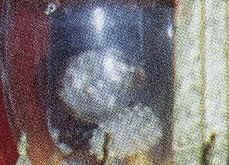|
|
|
||
|
ผู้เข้าอ่าน ตั้งแต่เมษายน 2022 After reading the content, do you agree with the information presented on this page? Please Click a Vote at POLLBAGEL
Do you agree that there are conflicting information on ARCHEOLOGICAL
EVIDENCES presented in the Tipitaka and those in Ancient India?
Overall, are you convinced that Lord Buddha and his monks lived in the
land comprising Thailand, Laos, Kampuchea, Myanmar, and Raman?
Webmaster:
chaiyongusc@gmail.com
|
In the Ancient India, less than 200 archeological signs are present compared to ten thousands of those found in Thailand and its neighbors. Besides those claimed to be the Birthplace at Lumpini in Nepal, the Enligntenment Bhodi Tree at Bodha Gaya, the First Preaching site at Deer Park, the Buddha's Deathplace and a few stupas at Sanji, the caves at Ajanta, and the Nalanda University totaling less than 121 places, there were no other traces of Buddha presences such as the Buddha's footprints, the Buddha's Laser-like on-stone imprinted shadows, the Chedis, or the Wiharas left to be seen. The inscription pillars, James Prinsep deciphered the name of a king-King Devanum Piya Piyadassi (the authentic name was King Tewanum Piyadissa) which were later identified as Asoka pillars because of George Turnour, a British in Ceylon who studied Buddhism. Turnour informed James Prinsep that Devanum was the same as King Asoka, the greatest patron of Buddhism as mentioned in the Buddhist Scripture. With the words of this man. George Turnour, King Devanum of India became King Asoka and honoured as a Great King of India. From various evidences, it's obvious that the two kings sharing the same name of King Asoka were actually two different kings.. One was the Indian King of Ujaini, claimed to be the same as King Devanum Piya Piyadassi, who erected the Asoka pillars inscripted with Brahmi alphabets. Another was Thai King Sri Dhamma Asokaraj of Patalibutra, a city located in Northern Thailand. According to an evidence found on theJaruk Wat Sri Chum (stone inscriptions of Wat Sri Chum Temple in Sukhothai), it clearly stated by Venerable Sri Satharajmuni that Patalibutra, King Asoka's Capital City, was in Thailand with the distance of only two-three nights away from Sukhothai, a former capital of Thailand. Here is a conflicting story of the two Asoka Kings: According to the Sankitiyawong, the book on history of Buddhism written in AD 1788, the Thai King Asoka's two children, Prince Mahindra and Princess Sanka Amita, were born of Buddhist mother in Ujaini (Uthai Thani). When Mahindra was ten years old, Asoka was crowned King of Ujaini. But for Indian King Asoka, his first son's eye was snatched out by his mother and there was no mention about Prince Mahindara and Princess Sanka Amitta in the pillar inscription. King Asoka collected the relics of Buddha from many cities and had 84,000 chedis and wiharas built in 84,000 towns in Choompoodaweep (the Pali word refered to as the Buddha's Birthplace land embracing the present main land Southeast Asia called Suwannabhumi). Soon Prince Mahindra (20), followed by his sister Sanka Amita (18), became Buddhist monks. Mahindra Thera left Chompoodhaweep for Sri Lanka and re-established Buddhism in that island nation.
|
The years of Indian King Asoka's succession to the throne (BE 269/BC274) and the year of his passing away (BE 306/BC234) were different from those mentioned in the Buddhist Scripture/Tipataka. King Asoka (King Sri Thamma Asoka Raj)'s succession to the Throne was in BE 218/BC325. He patronaged the Third Revision (Sankayana) of the Tipataka/Scripture in BE 235/BC 308. King Asoka passed away in BE 259/BC284). So, who was the authentic one? The Indian Asoka's coronation in BE 269 was nearly 34 years after the First Recording of the Tripataka) but the Thai Asoka led the Third Sankaya in BE 235. Three years later, Mahindra Thera went to lead the Fourth Sankayana in Singhalese in BE 238 in Lankadwip in Southern Thailand, the areas stretching from Nakara Sri Thammathirat down to Malaya Pradesh (Presently Malasia). Lanka Dwip is not in Ceylon as present;y understood, even the name of Ceylong was changed to Sri Lanka not long time ago. Mr. George Turnour might be wrong to inform James Prinsep that Asoka was consecrated 218 years after the Buddha's enlightment. In fact it was 218 years after the Buddha's death. All the years were mixed up and wrongly calculated because of inadequate information about the authentic history of Buddhism and the history of the Godama Buddha as recorded in ancient documents in Thailand, Laos and Burma. They were actually different kings! We do not deny the existence of King Devanum Piya Piyadassi, but we disagree to the claim that King Devanum was the same as King Asoka. In Suwannabhumi, there are countless of chedis, Buddhist wiharas, Buddha relics, footprints, and laser-like inprints of Buddha's shadows on the cave walls. Even a piece of Semhadhat, stone-turned blood strained saliva of Lord Buddha, found on the day the Lord Buddha entered Nirvana, was still intact and kept in a temple in Petchaburi Province near Krokesinrai, the death place of Buddha in Western Thailand. All over Thailand, Laos, Burma and Raman, visitors find ten thousands of archeological artifacts related to the Lord Buddha. In Buddha's time, Campochea was located in a big island called "Gururaj" (Land of Sand). This names "Gururaj" and "Indiapat Nagara" was recorded in the official record of King Naresuan's victory over King Lawag of Cambodia. This is one of the cue Sir Alexander and his team might have used to justify that Buddha was born in Hindustan (Ancient India). During 1854, Nepal was still a part of Hindustan. For all of these evidences and conflicting information, we, the research team, began searching for truth. Please click at the buttons above to read more and give a fair judgment if the Buddha's birthplace is in the Ancient India or in the present land of Suwannabhumi?
|
Soon the information below
will be available in English
New Information:
|
Webmaster: chaiyong@buddhabirthplace.com; chaiyongusc@gmail.com
Updated: March 10, 2022




